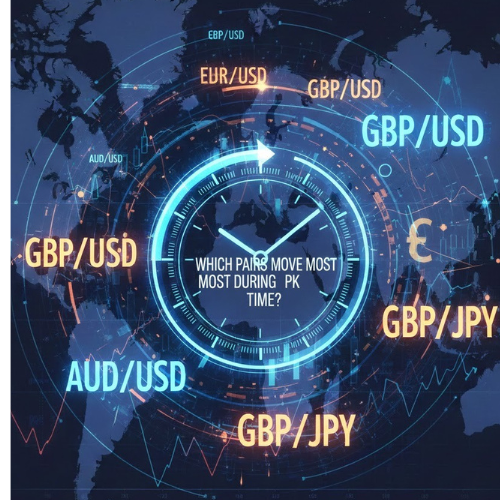Last Updated on March 18, 2024 by symip
Forex trading is a dynamic and demanding field. It requires a thorough awareness of many indicators to make well-informed decisions. Forex trading is a global platform for exchanging currencies. A firm understanding of important indicators is essential for a forex trader. It helps them to successfully navigate the complex foreign exchange market. To improve their trading chances and raise their chances of success, forex traders need to understand the following four crucial indicators.
In this blog post, we’ll quickly go over the four fundamental indicators. They make up the foundation of forex trading. Additionally, it allows even the most inexperienced trader to advance to the level of an expert or funded trader with sound knowledge and abilities.
Moving Averages
In the world of forex trading, moving averages are fundamental indicators. They enable traders to recognize and efficiently track trends. It becomes simpler to determine the general direction of the market when price data is smoothed down. When combined into a single flowing line using a moving average, it becomes easy to analyze the data.
Simple moving averages (SMAs) and exponential moving averages (EMAs) are the two primary types of moving averages. The EMA is more sensitive to the state of the market. The fact is, it gives recent prices more weight than the SMA. The SMA gives equal weight to all prices in the computation.
To determine the general direction of price activity, the moving average is a plotted line. It simply indicates the average price of a currency pair over a given period, such as the last 200 days or a year.
You will see that by simply adding a couple of moving averages to the chart, a trade idea forms. By using moving averages to spot trade opportunities, you can take advantage of momentum by placing a trade. When the currency pair is moving in the moving average’s direction and exiting when it starts to move in the other direction, you can place a trade.
Moving averages are frequently used by traders to spot trend reversals. They validate the strength of an already-established trend. Short-term and long-term moving average crossovers can indicate entry or exit positions. It offers insightful information about future market movements.
Relative Strength Index (RSI)
One oscillator that is easy to use and useful in its application is the Relative Strength Index. When a currency is oversold, a reversal is imminent. These situations can be identified using oscillators such as the relative strength index. The RSI is one of the best indicators for you if you prefer to “buy low and sell high.”
A momentum oscillator that gauges the velocities and variations in price movements is the Relative Strength Index. A market is considered overbought if the relative strength reading is above 70. On the other hand, the market is oversold if it is below 30. The relative strength index is expressed as a numerical figure between 0 and 100.
To find better entry and exit prices, the RSI works just as well in range-bound or trending markets. You can act on buy or sell indications when markets are ranging and lacking a distinct direction. One advantage of trend trading is that it makes it easier to determine which way to trade you need to select. You only need to enter the trend when the indicator is beginning to recover from extremes.
Forex traders can avoid frequent mistakes connected with market extremes by using RSI. It helps them make better-educated decisions about entry and exit positions.
Fibonacci Retracement
A technical analysis tool known as the Fibonacci retracement is based on the Fibonacci sequence. It is a mathematical idea that shows natural patterns in a variety of phenomena, including financial markets. To determine probable levels of support and resistance in a price trend, traders use the Fibonacci retracement indicator.
Are you ready to explore the fantastic benefits of Fibonacci retracement? Forex traders can anticipate possible market reversals and improve risk management by using Fibonacci retracements. It assists them in making more educated decisions about entry and exit positions and helps them achieve long-term profitability.
Fibonacci retracement levels that are significant and crucial are 23.6%, 38.2%, 50%, 61.8%, and 100%. These levels are used to indicate possible reversal zones. They indicate a possible reversal trend on a price chart. Traders frequently keep an eye on these levels. It helps them spot potential retracement points before the price resumes its initial direction.
The psychological effect on market participants is frequently cited for the efficacy of Fibonacci retracement. A self-fulfilling forecast is created when traders and algorithms respond to these levels. More buying or selling activity may ensue when several traders see the same Fibonacci level as a possible turning point.
Fibonacci retracement is used by traders to determine different levels. These levels indicate a point at which a financial instrument’s price is anticipated to retrace before continuing in the original direction after a notable price movement.
Bollinger Bands
Bollinger bands are a flexible tool that incorporates volatility bands. It is a basic moving average. The bands show price volatility and possible trend reversals. It’s a visual representation of expanding and contracting in response to changes in the market. Prices touching the upper band may indicate a reversal. The market is about to occur because it is likely overbought. On the other hand, prices that approach the lower band can be an indication of an oversold situation. It represents a possible buying opportunity.
When volatility is minimal, traders can also use Bollinger bands. It is used to spot the start of a new trend. A breakout from this consolidation may mark the beginning of a new trend. It is indicated by the band narrowing.
Insights into market volatility, possible breakouts, and trend reversals can be gained by using Bollinger bands. It is an invaluable tool for traders. Bollinger bands work best when combined with other analytical techniques. It is much like any technical indicator. To make well-rounded trading selections, traders should think about implementing risk management techniques. It keeps up with market fundamentals. You need to hone your technique to fit your trading style and risk tolerance, just like you would with any other trading tool.
Perks of Essential Indicators for Forex Traders
Gaining the fundamental indicator concept is like having a compass in the middle of the ocean when you are a forex trader. Every signal offers distinct perspectives; integrating them methodically improves the precision of decision-making. Keep in mind that there is no one-size-fits-all strategy. Note that great traders frequently tweak their tactics after carefully examining several indications. In the demanding but lucrative world of forex trading, the key to realizing the full potential of these crucial indicators is constant learning. It offers flexibility and disciplined risk management.
Final Words
It’s important to remember that these indicators provide a detailed picture of the market’s circumstances. When combined, you can make an accurate risk management strategy, which is crucial for any trading tactic. Forex traders can increase their chances of attaining long-term success by becoming proficient.
These crucial indicators will help them navigate the market’s complexity with more confidence and accuracy.





